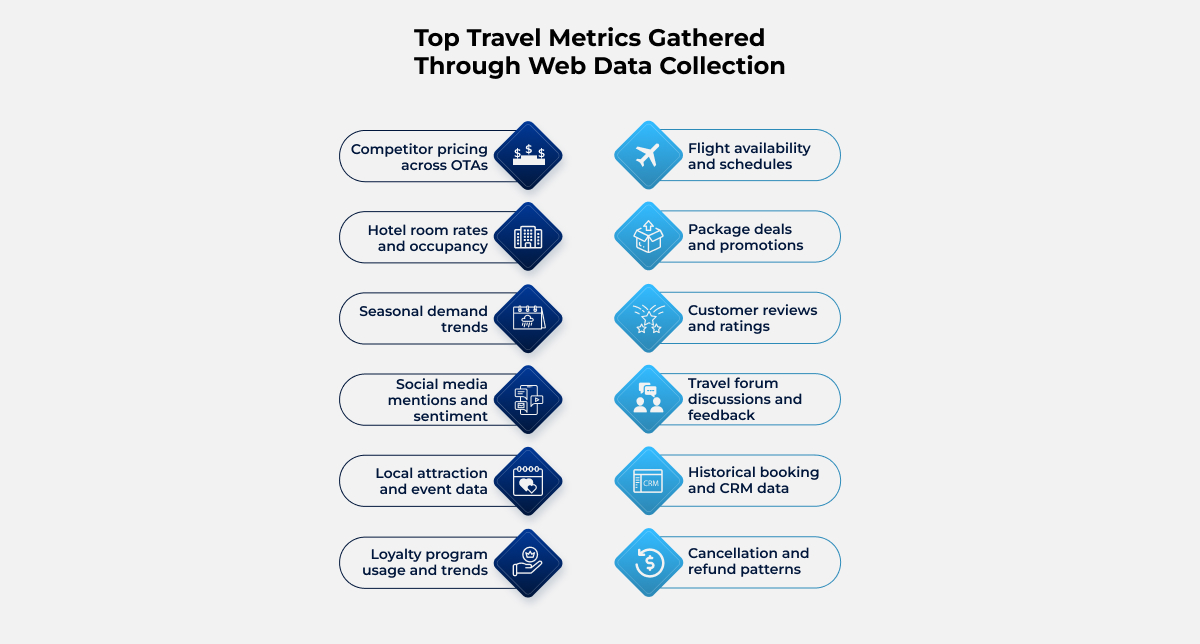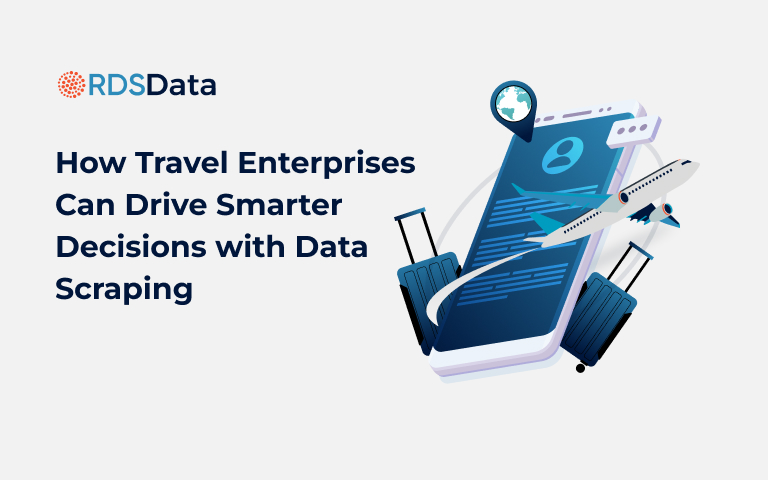The travel industry is one of the most competitive and data-intensive sectors in the global economy. Every decision, whether it’s setting flight prices, offering hotel packages, or predicting seasonal demand, depends on timely and accurate data.
Yet, most travel companies struggle with fragmented information scattered across booking platforms, competitor websites, customer reviews, and social media.
This is where data scraping (also called web data extraction) becomes essential. By collecting real-time data at scale, travel enterprises can make informed decisions, remain competitive, and improve customer experiences.
What do recent industry reports highlight?
- The global online travel market is projected to reach $1.84 trillion by 2031 (Allied Market Research).
- 47% of travel companies use data analytics to enhance marketing efforts (ZipDo, 2025).
- Customer sentiment is becoming central: As 81% of respondents of 23,000 users across 12 markets reported always or frequently reading reviews before booking accommodations (TripAdvisor Insights).
For high-level management, the real question is not if data scraping is necessary, but how it can be strategically applied to revenue optimization, marketing strategies, and staying competitive in a dynamic global travel environment.
Understand Data Scraping in the Travel Industry
What is Data Scraping?
Data scraping is the process of automatically extracting information from multiple digital sources. For travel enterprises, this could mean collecting:
- Competitor pricing and availability from OTA platforms.
- Customer sentiment from reviews and social media.
- Market trends from blogs and travel forums.
- Internal data from CRM systems.
Unlike manual data collection, scraping uses crawling engines, parsers, and structured pipelines to process large volumes of data in real time, ensuring accuracy and scalability.
Why Travel Enterprises Rely on Web Data Scraping

Travel enterprises need scraping for several critical reasons:
- Monitor competitor pricing across regions and platforms.
- Track dynamic market conditions, such as flight demand during peak holidays.
- Collect customer sentiment analysis from reviews, ratings, and comments.
- Enhance marketing strategies by analyzing customer behavior on social media.
- Ensure data-driven decision-making for forecasting and planning.
In short, scraping is not just a technical tool, it’s a strategic enabler for global travel companies to remain competitive.
Key Benefits of Data-Driven Decision Making for Travel Enterprises
Revenue Optimization
Dynamic pricing requires real-time data. Airlines and hotels often adjust rates dozens of times a day based on competitor movements. By monitoring competitor prices and demand patterns, enterprises can adjust their own offerings instantly.
Competitive Intelligence
To remain competitive, enterprises must know what rivals are doing. Data scraping enables continuous benchmarking: tracking competitor promotions, package inclusions, and seasonal discounts. This helps leaders avoid blind spots and make informed decisions on product positioning.
Customer Insights & Personalization
Modern travelers expect personalized recommendations. By analyzing customer reviews, booking histories, and social media conversations, enterprises can tailor marketing strategies. According to Luxury Travel Advisor, “Affluent Sentiment Study” survey of 288 luxury travel advisors, April 2022, 68% of luxury travelers prefer experiences tailored to their individual preferences, highlighting the value of effective data collection and analysis.”
Operational Efficiency
Scraping automates repetitive tasks like monitoring availability or scanning thousands of reviews. This reduces manual errors, staff workload, and time-to-decision, allowing leadership teams to focus on strategy rather than operational bottlenecks.
Strategic Planning & Forecasting
Accurate forecasting depends on timely data. For example, analyzing travel forums can reveal emerging destinations before they become mainstream. This allows travel agencies and operators to expand offerings proactively.
Critical Data Sources Travel Enterprises Should Monitor
OTA Platforms (Booking.com, Expedia, Airbnb)
OTAs are where pricing wars happen. Monitoring them ensures competitive pricing strategies are aligned with market demand.
Airline & Hotel Websites
Direct scraping from suppliers helps enterprises verify rate parity, detect undercutting, and align with global distribution systems.
Review & Social Media Platforms
Platforms like TripAdvisor, Google Reviews, Instagram, and TikTok provide a goldmine of customer sentiment. Reviews directly impact brand perception and revenue.
Travel Forums & Blogs
Communities like Reddit, Lonely Planet forums, or niche travel blogs often identify emerging travel trends before mainstream adoption.
Internal CRM & Historical Booking Data
Scraping isn’t limited to external sources. Integrating internal booking history with external insights creates a 360-degree view of customer behavior.
Challenges & Limitations of Data Scraping in Travel
Legal and Compliance Considerations
Enterprises must comply with GDPR, CCPA, and website terms of service. Non-compliance risks fines and reputational damage.
Data Quality & Accuracy
Scraping raw data is not enough. It must be validated, deduplicated, and normalized to avoid flawed decision-making.
Technical Complexity
Enterprise-level scraping involves handling JavaScript-heavy sites, CAPTCHAs, rotating proxies, and geo-targeted content. This requires advanced infrastructure and engineering expertise.
Competitive Blocking & Anti-Scraping Measures
Many OTAs use rate limits, IP blocking, and bot detection. Enterprises need scalable anti-blocking solutions to ensure uninterrupted data flow.
How Travel Enterprises Can Use Scraped Data to Make Smarter Decisions
Dynamic Pricing & Revenue Management
By continuously scraping competitor pricing, enterprises can implement dynamic pricing models that react instantly to demand fluctuations.
Package & Itinerary Optimization
Analyzing competitor packages helps in creating attractive bundles. For example, if data shows rising interest in cultural tours, agencies can adjust itineraries accordingly.
Personalized Marketing & Customer Retention
Sentiment analysis from reviews enables enterprises to fine-tune messaging, address pain points, and improve customer experiences.
Competitor Benchmarking
Scraping provides quantifiable benchmarks for service quality, pricing tiers, and add-ons, allowing enterprises to evaluate their own offerings objectively.
Strategic Market Expansion
Data from social media and forums highlights new hotspots (e.g., post-pandemic travel trends toward remote islands). Enterprises can expand before competitors.
Best Practices for Data Scraping in the Travel Industry
- Ensure ethical and compliant practices aligned with data regulations.
- Build scalable pipelines that can adapt to changing site structures.
- Integrate scraped data with business intelligence dashboards for executives.
- Focus on data freshness, since outdated travel data is often useless.
- Use AI-driven sentiment analysis to process unstructured data like reviews.
Future Trends: Data-Driven Travel Enterprises
The future of the travel industry is inseparable from data-driven decision-making. Key trends include:
- AI-powered predictive analytics for pricing and demand forecasting.
- Real-time dashboards integrating external scraping + internal CRM.
- Greater reliance on sentiment analysis to gauge traveler preferences.
- Automation at scale, reducing dependency on manual analysis.
- Sustainability insights: monitoring how travelers discuss eco-friendly travel online.
RDS Data: Your Data Partner
At enterprise scale, travel companies need a strategic partner to manage data collection, validation, and integration. RDS Data specializes in helping businesses leverage structured, real-time insights to make smarter, faster, and more competitive decisions.
Key Takeaways
- Data scraping is the foundation of competitive travel business strategies.
- Real-time, accurate, and validated data enables dynamic pricing, personalization, and forecasting.
- Travel enterprises must monitor OTAs, reviews, forums, and internal data simultaneously.
- Legal compliance, scalability, and data quality are the biggest challenges.
- The future lies in AI-driven, real-time decision-making platforms.
FAQs
Tired of broken scrapers and messy data?
Let us handle the complexity while you focus on insights.

